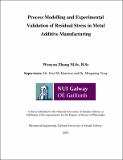Process modelling and experimental validation of residual stress in metal additive manufacturing

View/
Date
2021-09-06Author
Zhang, Wenyou
Metadata
Show full item recordUsage
This item's downloads: 456 (view details)
Abstract
Additive Manufacturing (AM) is an increasingly attractive advanced manufacturing technology that manufactures three-dimensional (3D) components, usually in a layer-by-layer manner, as opposed to subtractive or formative processes. Comparing with the traditional metal manufacturing techniques, AM has unrivalled capability for manufacturing complex structures and customised metal parts on an industrial scale and thus industries such as medical-device and aviation are adopting AM as a manufacturing method. However, the layer-by-layer approach, as well as indeed the continuous fine melt pool tracing process at each layer, leads to a complex sequence of repeated localised heating, melting, cooling and solidification steps. At any given time in a metal AM process, a microscale volume of the material will be exposed to rapid heating, whilst other regions will either be molten, solidifying, or cooling and solidified. As a result of this, the thermal residual stress (RS) within AM parts is intricate and is considered to be limiting a wider uptake of metal AM in industry. AM RS and the prediction thereof, is the focus of this thesis.
Finite element modelling (FEM) is capable of simulating aspects of the multi-physics AM process, but when applied to complete AM processes and parts, conventional FEM techniques accrue prohibitive computational expenses and thus are generally applied to simulating basic phenomena on small single components in basic AM representations. This thesis aims to build thermo-mechanical models for AM, to improve RS predictive capability and then inform RS mitigation strategies in additively manufactured metal components. In this content, coupled thermo-mechanical FEM capabilities for multi-processes, multi-laser beam and multi-part build were developed.
Powder bed fusion (PBF) is the most popular and widely used method to additively manufacture 3D metallic components. Ti-6Al-4V titanium alloy is one of the most popular metallic materials for PBF due to its favourable properties and is therefore utilised in this thesis. A novel computationally-efficient thermo-mechanical coupled laser beam powder bed fusion (PBF-LB) process model for part-scale Ti-6Al-4V components were developed. The influences of resolution, energy input and heating step time and cooling step time were characterised, which provide guidelines for the ‘layer scaling’ technique in PBF-LB process modelling for macroscale component. The results indicate that the ‘layer scaling’ method was effective when scaling up to 4 times the physical layer thickness and scaling the cooling step time. To validate the developed thermo-mechanical PBF-LB prediction model, RS measurement was performed by synchrotron high energy X-ray diffraction on parts with different heights and manufactured by different scanning strategies. The computational modelling results of directional stresses were compared with the experimental measurements.
To improve the production rate of metal PBF, multi-laser beam powder bed fusion (PBF-MLB) technology has been proposed as the next generation of PBF-LB technology. Thus, a computational multi-laser beam model was developed and presented in a study on RS in PBF-MLB. To investigate the optimum multi-laser scanning strategies in PBF-MLB, the influence of twelve different scanning strategies on temperature, the final resulting RS, and the z- (build) direction deflection by dual laser beams were investigated. The prediction indicates that the more laser beams are employed in PBF-MLB manufacturing, the lower RS and deflection resulted. The four-laser beam PBF-MLB build can mitigate RS by 9.39 % compared to the single laser beam PBF-LB.
Most of the existing FEM is focused on single part manufacturing, which is inconsistent with the practical multi-part (full build plate) printing observed in industry. Therefore, multi-part build process PBF-LB model was developed by the layer-by-layer modelling method for mitigating RS of the manufactured parts. Effects of the number of parts per build and part spacing on temperature and RS were investigated on prism sample in PBF-LB. It was found that RS decreased with the number of parts per build and RS of four-part build was 94 % of the single part build.
The final studies within this thesis apply the computational techniques to the electron beam variety of PBF (PBF-EB), to another metal AM process- directed energy deposition (DED), and to a new titanium alloy Ti2448 and aluminium alloy. The predicted temperature evolution during PBF-EB was indirectly compared to microstructure evolution of material performed by collaborators. Preheating temperature of the base plate was shown to be a key factor to reduce RS in PBF-LB. To interpret the in-situ RS characterisation of practical DED, process modelling of a thin trapezoidal plate was performed by using a bead-by-bead modelling method. The higher the numbers of layers fabricated in DED, the higher the temperature of the part during the manufacturing process, giving a 21.93 % lower temperature gradient and hence lower RS. The computational DED process modelling proved to be an effective tool to investigate temperature and RS state evolutions in macroscale components.
This work reveals further insights into AM RS mechanics and will inform metal AM part designers and process operators of optimum process configuration in order to minimise RS of metal parts in AM.

